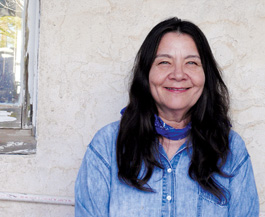home | metro santa cruz index | a&e

DESERT DWELLER: Leslie Marmon Silko's new book is part memoir,part meditation on the arid landscape she's lived in for 30 years.
Silko Speaks
The award-winning Native American author breaks her decade-long authorial silence with a self-portrait
By Cat Johnson
IN 1977, just a few months after the publication of her bestselling novel, Ceremony, Leslie Marmon Silko found herself alone in a hospital bed in New Mexico, face-to-face with her own mortality. She was about to undergo emergency surgery for a ruptured ectopic pregnancy, a procedure that was risky but without which she would certainly die. The possibility of death helped her, as the saying goes, to focus. "Up until then, I had been concerned with doing everything that everyone wanted of me," Silko says from her home in Tucson. "That night I kind of went over things, and I wondered if there was anyone who I hadn't done well by, and I realized that the only one I hadn't taken good care of was me."
Silko came out of the surgery with the awareness that she had more books to write but that she needed to make a change. Two months later, she moved to the Arizona desert, where she has spent the last three decades living among the cacti and coyote, focused on her writing. "In order to have a peaceful death, it's very important to do everything that you passionately want to do," she says. "You won't regret what you've done, you'll only regret what you didn't do."
Since her move to the desert, Silko, who has been awarded a MacArthur "genius grant" and called a Native American literary master, has written numerous poems, short stories and novels, including Gardens of the Dunes and Almanac of the Dead. Her latest book, The Turquoise Ledge, is her first in 10 years. She calls it a self-portrait.
The book begins with Silko's memories of growing up on the edge of the Laguna Pueblo reservation in New Mexico and provides a glimpse into her extended family with accounts that are humorous, heart-wrenching and insightful. Her father's passion for photography, the English-only schools, breaking in a new saddle the hard way and stories of her ancestors all help to paint a vivid picture of the author's early years.
The Turquoise Ledge then opens up into the slow warmth of Silko's present-day life, where she spends her days walking in the arroyo, observing the wild beauty of the desert, tending to her animals and working on her manuscript, whose central theme is the turquoise in and around her home. She tells stories of the stone's history among the desert people, breaks down its distinguishing characteristics, describes the pieces she finds on her walks and fantasizes about finding an enormous ledge of it.
The majority of the book is dedicated to quiet observations about the world around her. Humans, when they are mentioned, are done so sparingly. "I just get fed up that humans are so self-important," Silko says. "I wanted to say, 'Look, there are other ways to look at the world, and we're really not any more important than rattlesnakes.'"
Through numerous tales of encounters and friendships, rattlesnakes play starring roles in The Turquoise Ledge. "My mother taught us not to be afraid of snakes, so I started out my life with a pretty good attitude toward them," Silko says. "They are very peaceful beings with a generosity of spirit, even though they've been hunted so cruelly by humans."
Silko's intimate knowledge of life in the desert is nothing new; however, her venture into writing a memoir presented challenging terrain. "With fiction, the characters come alive very early and you just follow them along, but writing nonfiction is hard for me," she says. "When I got started in the section about my ancestors, I said to myself, 'What was I thinking?' I look at every word and think, 'Is this completely, absolutely true from every angle?' It was torturous for a while."
Before starting The Turquoise Ledge, Silko made a conscious decision to keep the focus on the land and leave politics out of this book, but she found that to be an impossible task. "I was just going to focus on the desert and the solitude and what gives me positive energy," she says. "But even when you try very hard to focus on the positive, there's no escaping that conflict."
The Indian slave trade, the testing and storage of radioactive materials, encounters with the local earth-gouger and authorities who look the other way are all illuminated in The Turquoise Ledge. The book in its entirety, however, is a tribute to life as seen through Silko's eyes. From the majesty of a desert rainstorm to the iridescent shimmering of an insect, she brings a gentle awareness to the beauty of the natural world. "I'm really blessed," she says. "I just write the things that make me happy, and hope that other people will be able to share in my happiness."
LESLIE MARMON SILKO
The author reads from 'The Turquoise Ledge' on Thursday, Oct. 21, at 7:30pm at Bookshop Santa Cruz, 1520 Pacific Ave., Santa Cruz. Free. 831.423.0900.
Send letters to the editor here.
|
|
|
|
|
|